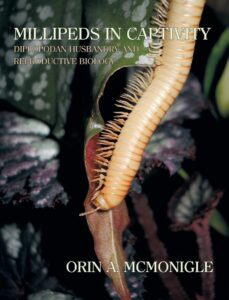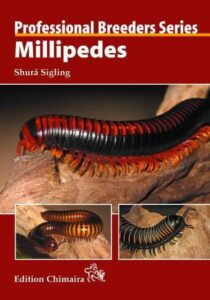If you are looking for an exotic pet to keep with minimum effort, you should consider the millipedes. Here’s a quick guide for keeping millipedes as pets.
House the millipedes in a ventilated container with 3-5 inches of peat moss, flake soil and dried leaves. Keep the substrates moist and replenish the substrates when more than half are consumed. You can give them some snacks such as cut fruit or soaked dog biscuits but it is not required.
That’s pretty straightforward isn’t it? Let’s continue with more details.
Common Species of Pet Millipedes
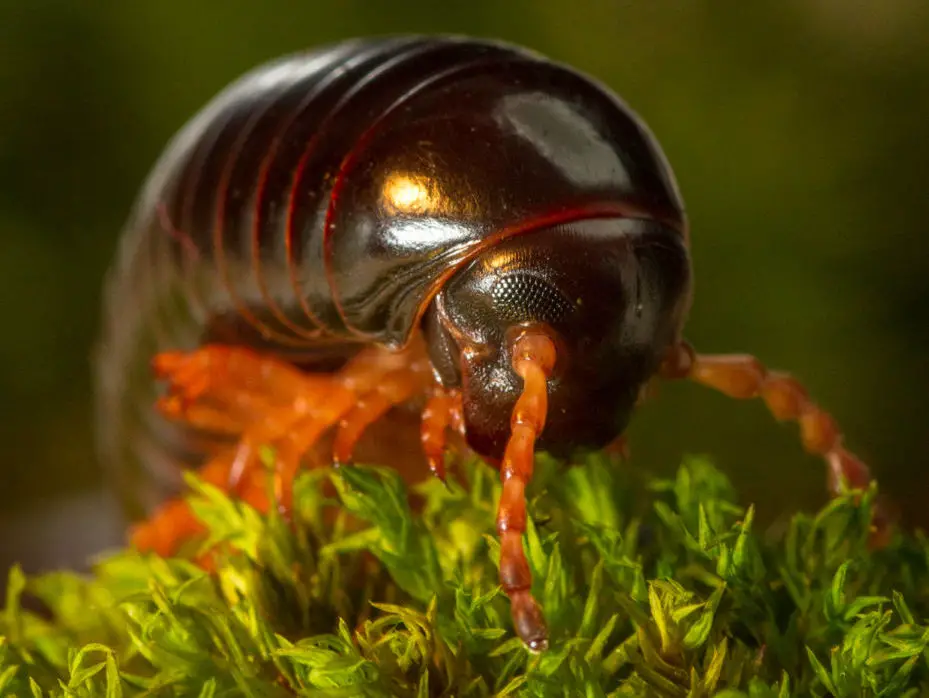
Below are the 7 notable millipede species commonly kept as pets. I have listed both their scientific names and common names. Note that different people might use the same common name for different species or different common names for the same species. Do also bear in mind that it is quite easy to mix up different species with similar appearance.
| Common Name | Scientific Name | Origin | Length | Known for |
|---|---|---|---|---|
| African Giant Millipedes | Archispirostreptus gigas | Africa | 13” | Largest millipede. Rare, as importing is banned. Can live for more than 7 years. |
| Philippines Flame Legs | Trigoniulus macropygus | Borneo | 4” | Dark red body with light red rings and flame-like red legs with yellow tips. Legs glow under black light |
| Thai Rainbow Millipedes | Apeuthes spp | Thailand | 5” | Bluish body with amber rings. Can live for 7 years and more |
| Rusty Millipedes | Trigoniulus corallinus | Asia | 2” | Fairly common millipedes with scarlet body |
| Florida Ivory Millipede | Chicobolus spinigerus | Southeastern US | 3.5” | Different color morphs. A particular morph has body with purple sheen |
| Eastern Red-ribbed Millipede, Iron worm | Narceus americanus | Northeastern US | 4” | Dark body with red bands. Can live up to 10 years. |
| Black and Yellow Flat-back Millipede | Apheloria virginiensis | Central and southeastern US | 2” | Flat and black body with amber/yellow edges and yellow legs. Excrete hydrogen cyanide that causes irritation on eyes and skins. |
There are a huge variety of millipedes for you to choose. Most of them are easy to take care of and have similar caring needs. If you don’t know which species to choose, just get the most affordable and accessible one, or the most attractive one.
Enclosure Setup
To house the millipedes, you need an enclosure with a width and length of at least 2 – 3 times the length of your millipedes. A 10 gallon fish tank will allow you to house multiple millipedes of medium or smaller species.
Choose an enclosure with a mesh lid. This will give your millipedes better ventilation while reducing the risk of intrusion by other insects.
If you are not using a mesh lid, make sure there are plenty of vents on the enclosure to allow better ventilation. This will help reduce molds.
Substrates
You might be wondering what do millipedes eat. Well, millipedes’ diet is rather straightforward. They eat decaying plant matter. This can be supplied in the form of substrates.
Most millipedes rely heavily on substrates to survive (there are exceptions). This is where they hide if the temperature is too hot. The substrates also provide them with adequate humidity to survive. Most importantly, the substrates contain decaying plant matters which the millipedes consume.
Mix pesticide-free and unfertilized peat moss, compost and coir in a 2:2:1 ratio. Add water to the substrates and mix thoroughly. The substrates should be moist enough to hold its shape momentarily when pressed with your hands without dripping water. Then, add a lot of dried leaves (preferably hardwood leaves) cut into small pieces.
Some hobbyists add a small amount of calcium carbonate for better exoskeleton formation, and some include flake soil as one of the main substrate components.
Fill the enclosure with substrates until it is 3-5 inches in depth.
Water
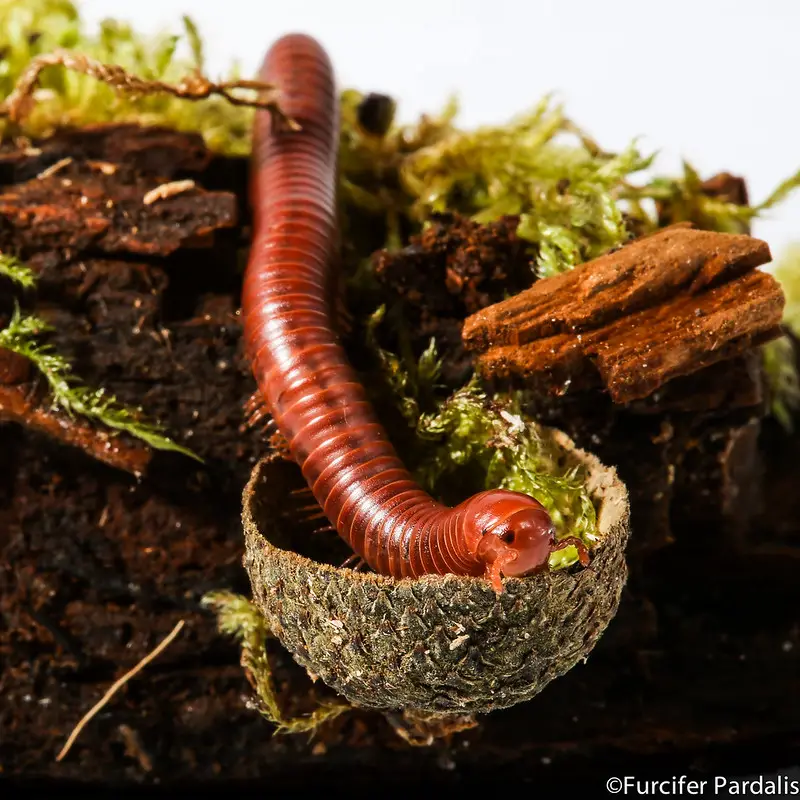
Millipedes obtain water from the substrates. Hence, it is important to keep the substrates moist. Mist the substrates once a week or when it seems dry. Note that the substrates shouldn’t be too wet either. Otherwise, your millipedes will have difficulties breathing.
While some argue that a water dish is not required, you can add one in the enclosure as a backup in case the substrates are too dry. Use a shallow dish so that younger millipedes don’t drown in the dish.
Decorating the Enclosure
Add a few pieces of cork bark or driftwood in your enclosure. This will increase the surface area available for your millipedes to crawl and explore. It also provides some hiding spaces for your millipedes.
Temperature
Most millipedes don’t require additional temperature control. Keep them at room temperature and they will survive well.
If it is cold (eg. in the winter), use a small heat mat to keep your millipedes warm. Fix the heat mat on one of the walls or underneath a corner of the enclosure. This will create a temperature gradient for the millipedes to move to the most suitable spot they prefer.
Lighting
Millipedes prefer to live in the dark. Hence, no lighting is required. In fact, your enclosure should be placed away from direct light unless you want to observe your millipedes.
Replacing the Substrates
As the millipedes feed on the decaying plant matter in the substrates, they produce fecal pellets. When you see more than half of the substrates have turned into fecal pellets, it’s time to replace the substrates.
Carefully scoop out the millipedes and spent substrates and put them in another container.
Take this opportunity to thoroughly clean the enclosure. Brush off any dirt and wash the enclosure using a mild soap.
After cleaning the enclosure, pour in the new substrates. Carefully move all millipedes back to the enclosure with new substrates.
Keep the spent substrates for about 2-3 months. Then, inspect the substrates to see if you can find any young millipedes that just hatched. You might have missed some smaller millipedes earlier which should have grown bigger and more conspicuous now.
Extra Snacks for the Millipedes
Some hobbyists add cut fruits or vegetables to feed their millipedes. You can use carrots, cucumbers, apples etc. These should be snacks instead of staple food for the millipedes.
Some hobbyists also give their millipedes soaked cat or dog biscuits for extra protein.
Do remove any unconsumed snacks after a day or two to prevent molds and other pests.
Handling Millipedes
Millipedes can be easily handled because they are relatively slow and they don’t bite or sting. You can safely hold them with your bare hands.
You should notice some holes along both sides of the millipede’s body. Those are called the ozopores. Millipedes secrete irritating fluid through the ozopores to deter their predators.
Secretion of certain species such as Apheloria virginiensis contain poisonous hydrogen cyanide. While it comes in low concentration, it can still cause irritation when contact with eyes or skins. Make sure you wash your hands after handling the millipedes.
Molting Care
Millipedes grow by molting until they turn into adults, which is typically 8-10 molts. In each molt, the millipede sheds off its exoskeleton and grows a new one.
The numbers of molt vary in species and sexes of the millipedes. In some species, male millipedes reach adulthood 1 molt earlier than the female. Some can molt even after they turn into adults. The stages between molts are called stadia (singular: stadium). Newly hatched millipedes are Stadium I, and the molt into Stadium II and so on.
Prior to molting, the millipede will stop moving as if it is dead. If you see your millipedes not moving, likely it is molting. Do not touch or disturb them because they are very fragile at this stage. The molting process can take up to a few weeks.
Breeding the Millipedes
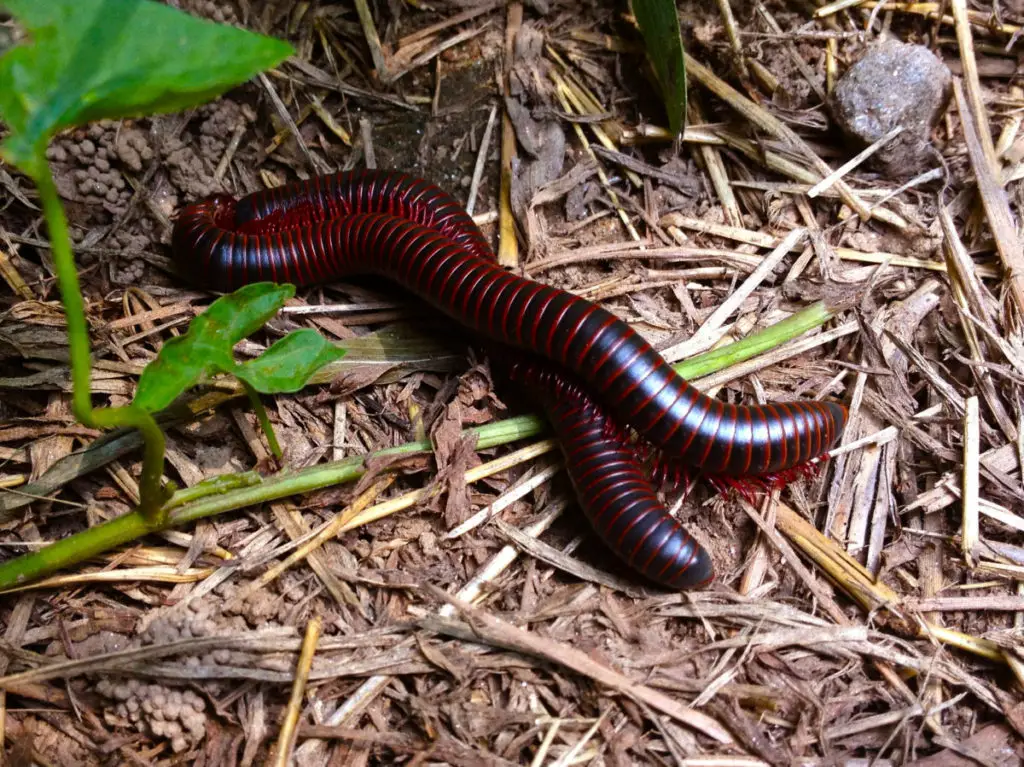
Millipedes can breed easily when adult males and females are housed together. Note that only sexually mature adults can breed, and it is rather difficult to identify if the millipedes are mature. But as long as you have both male and female millipedes, they will breed sooner or later.
Some millipedes lay eggs singly in the substrates while some lay eggs in groups. Sometimes, eggs can be hidden inside their fecal pellet. Hence, you should keep spent substrates for some time. Throw away the substrates only after you are sure that there are no eggs or you have transferred all the newborns.
No special care is required for the eggs and baby millipedes. They can be kept together with their parents.
How to Sex Millipedes
To sex millipedes, look for an apparent “gap” between legs at the anterior of the millipedes. The male has 1-2 pairs of short gonopods instead of legs on the 7th body segment, forming a “gap”. This is apparent in adults and the stadium before adults.
Gonopods are modified legs in male millipedes used for mating. They look like a dwarf version of the millipede legs. In some species/stadium, the gonopods are hidden.
Except for the first 4 segments and the last few segments, each segment of the millipede’s body has 2 pairs of legs. Since the male has either 1-2 pairs of gonopods or even hidden gonopods on the 7th segment, it looks as if there a gap between the legs (refer to the photo below).

Figure 2 of this research paper may give you a clearer picture if you are still confused.
Certain groups of millipedes may have different characteristics that can be used to distinguish their sex. For example, the 7th segment of male millipedes from the order Spirobolida is swollen and looks like a hump.
Recommended Supplies
Here’s my recommended supplies for your millipedes. Note that I get a small commission when you buy the items through the links in this page. This helps me to maintain the site without incurring additional costs to you.
The enclosure recommended above is not suitable for giant African millipede.
Further Reading
If you want to learn more about keeping millipedes, I recommend you to get 1 of these 2 books:
Millipedes in Captivity is a book by Orin Mcmonigle, the Guru in this hobby. This book covers everything you need to know about millipedes from biology, identification, care guide, breeding guide and more. It also covers a wide variety of species, so you definitely find information on those millipedes that you can keep.
The Millipedes (Professional Breeder Series) by Shura Sigling is another millipede keeping guide that you should consider getting. Like the other book, it covers all you need to know about millipedes, with more emphasis on tropical and subtropical species. Make sure you check the language of the book before buying!
Additional Information
Can I forcefully uncoil my millipedes?
Please don’t do that because it will hurt your millipedes!
My millipedes are coated with whitish fungus, what should I do?
Get an antifungal solution such as those containing clotrimazole. Dilute it to 0.1%. Use a cotton swab to apply the antifungal solution on the millipedes once every 3 days. Meanwhile, make sure your enclosure is adequately ventilated.
I saw something climbing on my millipedes. What should I do?
Those are likely mites. Wild-caught millipedes tend to come with mites. They live in a symbiotic relationship with the millipedes where they help clean the millipedes in exchange for food.
The mites don’t cause any harm to the millipedes. If there are too many of them, brush them off using a soft brush and move your millipedes into new substrates. Throw away the old substrates once you are sure there are no juvenile millipedes or eggs inside.

